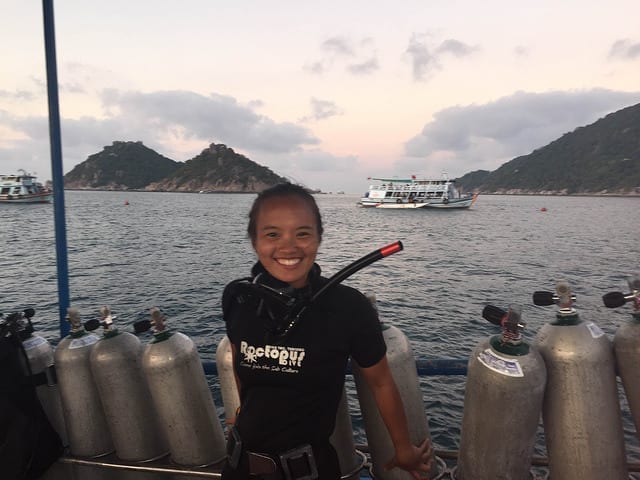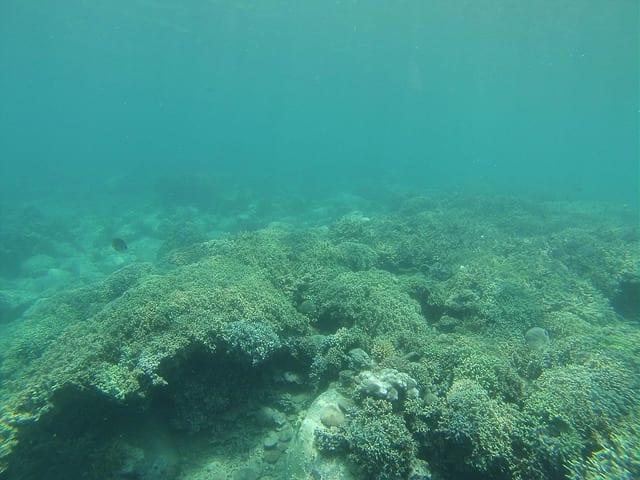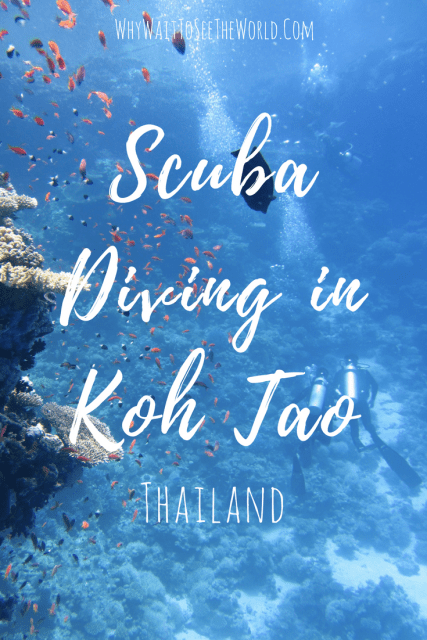When I was young, I was always afraid of the water. I didn’t learn to swim until well after my friends in school, and even when I became more comfortable with it, the thought of being in a place where I couldn’t breathe really scared me. My ten-year-old self would have never dreamt of going scuba diving.
My twenty-one-year-old self, however, had different ideas.
When I was planning out my original itinerary in Southeast Asia, I knew that I wanted to try diving so that I could finally see the underwater world. Snorkeling all my life has been fun, but I’ve always been in awe at the way that divers float through the water, weightless, up close and personal with coral reefs, giant rock formations, and marine life. I figured I should try for my certification in Koh Tao, one of the most affordable places to dive in the world.
Here is how I got my certification in scuba diving in Koh Tao.
Contents
Choosing A Dive School

There are dozens of dive schools in Koh Tao, most of which instruct under the PADI or SSI diving organizations. Both of these are internationally recognized dive certifications, so I didn’t worry too much about whether I should do one or the other. At first, it was hard to narrow down my choice from all of the possible dive schools – there were so many! In this stage, research and reading reviews were key elements of my decision process.
I did my research to find a school that has a low student to instructor ratio. I found this to be my most important criteria in my search for a school. There are schools of all sizes on Koh Tao, so I made sure to go with one that boasts small class sizes and personalized attention. I ended up deciding on an SSI dive school called Roctopus, which ended up being the perfect choice for me with its small class sizes, collegial atmosphere, and fantastic reviews from past students.
The Open Water Certification Experience

Luckily, when I arrived for my course, there were only four of us with one instructor. The certification took a total of four days, with a mixture of classroom and dive instruction. We also had written homework to complete in the evenings on our own time, as well as a textbook to read. It was hard work but worth it for the experience of scuba diving in Koh Tao!
The first day began with a 2-hour classroom session where we watched the official SSI education videos and filled out paperwork. Boring but necessary. Watching the videos did give me a better feel for what diving is like and what I should expect when I first enter the water. They also cover potential risks of diving and the preventative measures necessary.
Day 2 began with another classroom session in the morning, which covered more in-depth details about diving risks, best practices, and opportunities. Then, in the afternoon, we did our confined training in the water. This consists of certain skills like emptying water out of your mask and retrieving your regulator (breathing mechanism) if it falls out of your mouth. Typically, this happens in a swimming pool, but the water was shallow and calm enough at one of the dive sites that we got to perform our first session in the ocean! It was awesome and a great introduction to scuba diving in Koh Tao.

During the first diving session, we were assigned a dive buddy that we dove with the rest of the course. Mine was a friendly Finnish guy who ended up being basically like my Koh Tao brother. As we would soon find out, scuba diving in Koh Tao was as much a social thing as it was a technical one.
Day 3 consisted of a morning lesson covering dive tables, blood nitrogen levels, and developing an understanding of logistics for planning dives. Around lunchtime, we took a final written exam covering all of the materials (homework, videos, textbook, dive planning) that we had learned. I was a little nervous, but I passed with flying colors! Then, we took to the sea for our first official dive! It was nice to finally see coral reefs and wildlife, and with each dive, we became more and more comfortable with the feeling of being in the water.
Day 4 was the final day and it consisted of two morning dives. During the last dive, we showed off the mask and emergency skills we’d learned one final time before being awarded with a giant hug and a “CONGRATULATIONS!” from our instructor. Assuming you’ve passed the written test, done all of your homework, and successfully completed all of the underwater skills, you’ll get certified. And, of course, my classmates and I celebrated our “graduation” with drinks on the beach later that evening.
The SSI Open Water certification enables divers to dive up to 18 meters below the surface with a buddy. For many dive sites, this is more than enough to see awesome wildlife and coral reefs.
Continuing My Diving Education

After my Open Water course, I realized I loved diving so much that I wanted to do more. I soon signed up for another SSI course, the Advanced Adventurer certification, which would enable me to dive deeper and in many different scenarios. With my dive school, I got to keep my same instructor and dive buddy, too! This certification consisted of just five dives (no classroom instruction – woohoo!) across two days in five specialties – Perfect Buoyancy, Navigation, Night (Limited Visibility), Wreck, and Deep Dives.
The SSI Advanced Adventurer course enables divers to go down to 30 meters beneath the surface and gives an introduction to night diving and wreck diving as well. You also learn important skills such as buoyancy control, use of dive tools such as a dive computer and compass, and underwater navigation.
What’s Next?

Now that I’m advanced certified, I’m planning to dive wherever I can in the world. Since scuba diving in Koh Tao I have also been diving in Vietnam, and I plan to do a good amount of diving in the Philippines as well, which consists of a lot of deep diving and shipwrecks. These recreational, non-course dives are called “Fun Dives.” Diving is available in places ranging from Belize to Egypt, and I’m excited to make it a part of my travel routine!
Curious about Scuba Diving? Read On For Scuba Diving Myths Revealed!

